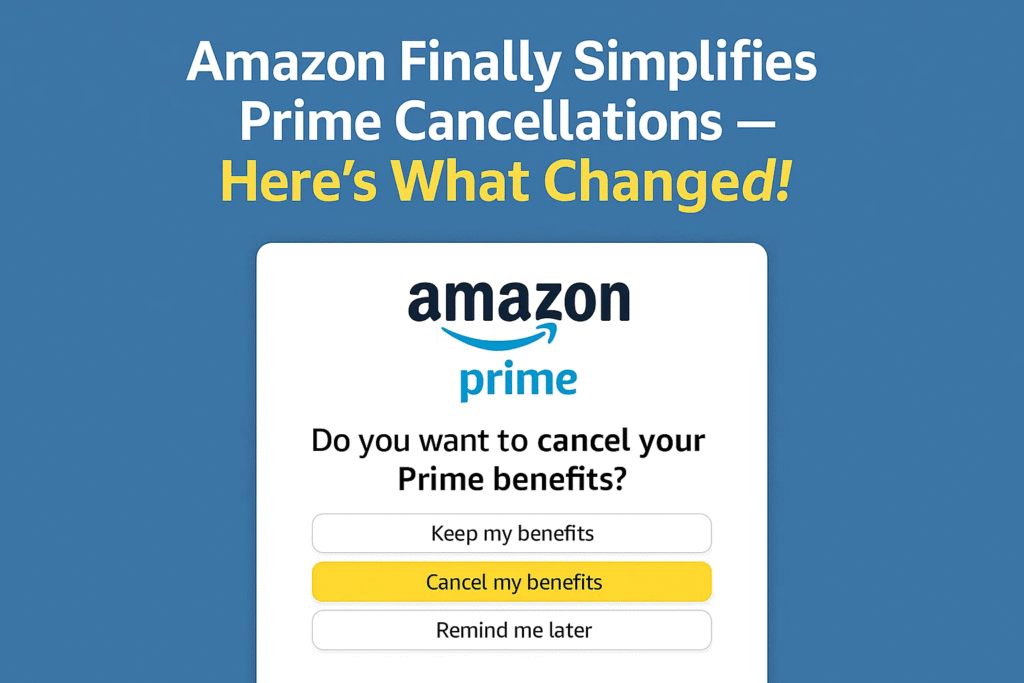If you’ve ever tried to cancel your Amazon Prime membership, you probably know how confusing it used to be. For years, users across the globe complained that canceling Prime wasn’t as simple as it should have been. Endless steps, unclear buttons, and repetitive confirmation screens made it feel like a maze.
But things have finally changed. Amazon has simplified the Prime cancellation process after years of regulatory pressure and consumer frustration. In this article, we’ll explore what changed, why it happened, how to cancel now, and what this means for users worldwide.
Let’s unpack this major shift in Amazon’s subscription strategy.
The Prime Problem: Why Cancelling Was So Hard
Amazon Prime is one of the most successful subscription services in the world. It offers millions of members benefits like:
-
Free one-day or two-day shipping
-
Prime Video and Prime Music access
-
Exclusive deals and discounts
-
Amazon Fresh and same-day grocery delivery
-
Prime Reading and Audible offers
But beneath those perks, there’s been one persistent issue — getting out of Prime was often an uphill battle.
For years, customers complained that the process to cancel Prime was confusing and manipulative. The design often involved multiple pages, repetitive confirmations, and “are you sure?” messages trying to make users reconsider.
Consumer advocacy groups and regulators called this tactic a “dark pattern” — a design strategy used to mislead or discourage users from completing certain actions.
The Pressure to Change: Regulators Step In
The shift didn’t come out of nowhere. Amazon’s decision to simplify Prime cancellations was heavily influenced by European and American regulatory action.
In 2022, the European Commission launched an investigation after receiving multiple complaints from consumer organizations. Their findings revealed that Amazon’s cancellation process violated transparency laws and misled users.
What the European Commission Found
-
Users faced multiple confirmation screens.
-
The “cancel” button was hidden behind multiple clicks.
-
The design included distracting language like “Are you sure?” or “You’ll lose benefits immediately.”
-
The user journey was far longer than needed — often four or more screens deep.
This was considered a violation of consumer rights under the EU’s Unfair Commercial Practices Directive.
As a result, Amazon was pressured to cooperate and simplify the process — not just in the EU, but globally.
Amazon’s Official Statement
In 2023, Amazon announced that it would be introducing a redesigned Prime cancellation process worldwide.
The company stated:
“We continuously listen to feedback and look for ways to improve the customer experience. We have made changes to the Prime membership cancellation process to make it clearer and more straightforward.”
While it might sound like standard corporate PR language, this change was monumental. It marked a shift from a “keep members at any cost” strategy to a “transparent and compliant” approach.
What Exactly Has Changed?
Now let’s dive into what’s actually new in the Prime cancellation process.
Below is a comparison table that highlights how the old process differed from the new one.
| Feature | Old Prime Cancellation Process | New Prime Cancellation Process (2025) |
|---|---|---|
| Number of Steps | 5–7 screens before completion | 2–3 screens maximum |
| Design Clarity | Multiple “are you sure?” pop-ups | Clear “End Membership” button |
| Navigation Path | Confusing menu with hidden options | Simple “Manage Membership” tab |
| Language Tone | Emotional persuasion (“You’ll lose benefits!”) | Neutral and factual |
| User Confirmation | Multiple layers of reconfirmation | One final confirmation |
| Global Consistency | Different flows in each country | Unified experience globally |
| Regulatory Compliance | Questionable | Fully compliant with EU & US standards |
This table makes it clear: Amazon has gone from confusion to clarity.
Now, users can cancel Prime in just a few clicks without feeling trapped or manipulated.
How to Cancel Prime Under the New System
Here’s a step-by-step walkthrough of how the simplified process now works.
Go to Your Account Settings
Open your Amazon account and navigate to “Your Account” → “Prime Membership.”
Locate “Manage Membership”
Once you’re on the Prime page, click on “Manage Membership.” You’ll now see clear options related to your subscription — renewal, benefits, and cancellation.
Click “End Membership”
You’ll see a bold, easily visible button that says “End Membership and Benefits.”
Confirm Cancellation
After clicking, you’ll be shown a single confirmation screen summarizing what you’ll lose and when your benefits end.
Click “Confirm Cancellation.”
And that’s it — you’re done.
No loops, no trick questions, no guilt-driven messages.
Why This Change Matters for Consumers
This isn’t just about convenience — it’s a matter of consumer rights and digital ethics.
Simplifying Prime cancellations signals that companies as large as Amazon are being held accountable for fair design practices.
Here’s why this matters:
-
Transparency: Users deserve to know exactly how to cancel without confusion.
-
Control: Customers regain full control over recurring payments.
-
Trust: Simplified design improves long-term brand credibility.
-
Precedent: It sets a standard for other subscription services.
When giants like Amazon adapt, others — such as Netflix, Spotify, and Disney+ — often follow.
The Role of Dark Patterns in Subscription Design
To understand why this is a big deal, it’s important to know what dark patterns are.
Dark patterns are user interface designs crafted to trick people into making decisions that benefit companies — not consumers.
Common dark patterns include:
-
Hiding the cancellation option deep in menus
-
Requiring multiple unnecessary clicks
-
Using guilt-driven or manipulative messages
-
Highlighting “Stay” in bright colors and “Cancel” in gray
For years, Amazon’s Prime cancellation flow was a classic example cited by consumer advocates.
By removing these elements, Amazon has taken a significant step toward ethical UX design.
How Regulators Framed the Issue
The European Commission, along with the Norwegian Consumer Council (Forbrukerrådet), led the charge against Amazon’s complex system.
In their 2022 report titled “You Can Log Out, But You Can Never Leave,” they argued that Amazon’s interface:
-
Manipulated emotions (fear of losing benefits)
-
Made cancellation cognitively exhausting
-
Violated principles of simplicity and fairness
After this pressure, Amazon worked closely with the Consumer Protection Cooperation (CPC) Network to fix its interface.
By mid-2023, the “new, simplified flow” was live in Europe — and in 2024–2025, it expanded to all major markets, including India and North America.
The Bigger Picture: Subscription Traps and Consumer Awareness
Amazon’s case is not unique. Many digital services — from streaming to cloud storage — rely on subscription traps, where users sign up easily but struggle to leave.
But consumer behavior is changing. Today’s users are:
-
More informed about recurring charges
-
Actively tracking subscriptions via banking apps
-
Demanding transparency from digital brands
With new digital consumer laws (like the EU’s Digital Services Act and California’s CCPA updates), companies are legally obligated to ensure fair practices.
Amazon’s move is both a response to law and a recognition of consumer sentiment.
Industry Reactions: Applause and Skepticism
The news of Amazon’s simplification drew mixed reactions from industry experts.
Some praised the move as “long overdue,” while others questioned whether the change went far enough.
Positive Reactions
Consumer rights groups, especially in Europe, welcomed the decision.
They noted that Amazon’s new interface respects the “two-click rule” — meaning cancellation shouldn’t take more than two meaningful actions.
Skeptical Views
Others argue that Amazon might still use subtle nudges, such as reminding users of “unused benefits” before final confirmation.
While the tone has become neutral, the strategic messaging still encourages reconsideration — just less aggressively.
Impact on Amazon’s Business Model
You might wonder — will this hurt Amazon’s bottom line?
Probably not in the long run.
Amazon’s Prime service has over 250 million global subscribers, generating billions in recurring revenue. While easier cancellation may cause short-term churn, it can boost customer goodwill and trust.
Research consistently shows that transparent brands retain more loyal customers over time.
By removing the friction, Amazon could attract users who were hesitant to join before — knowing they can leave easily.
What Users Are Saying
Early feedback from users across Reddit, X (formerly Twitter), and tech forums suggests the new cancellation flow is indeed smoother.
Here are some common sentiments:
-
“Finally, I can cancel Prime without hunting for hidden buttons.”
-
“The new process feels honest — no guilt trips.”
-
“About time Amazon made this normal!”
Others mentioned that while cancellation is now simple, reactivation remains one-click easy, which means Amazon still benefits from quick re-subscribers.
Comparison With Other Subscription Services
To understand how Amazon’s redesign fits in the bigger landscape, here’s a quick comparison with other major platforms:
| Service | Cancellation Difficulty (Before) | Now (2025) | Remarks |
|---|---|---|---|
| Amazon Prime | High | Easy | Simplified interface globally |
| Netflix | Medium | Easy | Transparent from the start |
| Spotify Premium | Medium | Easy | Clean user flow |
| Disney+ | Medium-High | Moderate | Slightly improved |
| Apple One | High | Moderate | Still hidden under Apple ID settings |
| Adobe Creative Cloud | Very High | Still High | Continues to use multiple confirmation layers |
Amazon’s shift now positions it alongside Netflix and Spotify as user-friendly in terms of subscription control.
A Broader Trend: Ethical UX and Digital Accountability
The simplified Prime cancellation process reflects a broader trend in the tech industry — ethical design and digital accountability.
In 2025, ethical UX is no longer optional. It’s an expectation.
Brands are being judged not just for what they offer, but for how they treat users during the entire customer journey — sign-up, usage, and cancellation alike.
This evolution aligns with global consumer protection trends emphasizing:
-
Simplicity
-
Honesty
-
User autonomy
Amazon’s redesign shows that even giants can evolve under the right pressure.
Lessons for Other Companies
There are several takeaways from Amazon’s move that other companies can learn from:
-
Transparency Builds Loyalty: Hiding information damages trust.
-
Compliance Saves Costs: Regulatory penalties can be avoided by fair design.
-
User Experience = Brand Image: A confusing process reflects poorly on reputation.
-
Ethics Are a Business Strategy: Being consumer-friendly is no longer optional; it’s a market advantage.
What This Means for You as a Prime Member
If you’re a Prime member today, this update gives you:
-
Full control over your subscription
-
The confidence to join or leave without friction
-
A clearer understanding of billing and renewal cycles
Even if you love Prime and plan to stay, this update means Amazon is listening — and improving the user experience where it matters most.
Future Outlook: What’s Next for Amazon Prime?
Amazon’s simplification of cancellations could be the first step toward broader user transparency.
Possible future updates may include:
-
Clearer renewal reminders
-
Pro-rated refunds for mid-cycle cancellations
-
Easy pause options instead of full cancellation
-
Simplified multi-user family management for Prime benefits
As Amazon competes with newer subscription models, these changes can strengthen customer satisfaction and regulatory goodwill.
Final Thoughts
After years of complaints and pressure, Amazon has finally done what many thought it wouldn’t — made Prime cancellations easy.
This shift is more than a UX update; it’s a reflection of evolving global standards for fairness, transparency, and user control.
While it took regulatory pressure to get here, the result benefits everyone.
For consumers, it’s freedom and clarity.
For Amazon, it’s credibility restored.
So, the next time you decide to end your Prime membership — you can do it without a battle.


